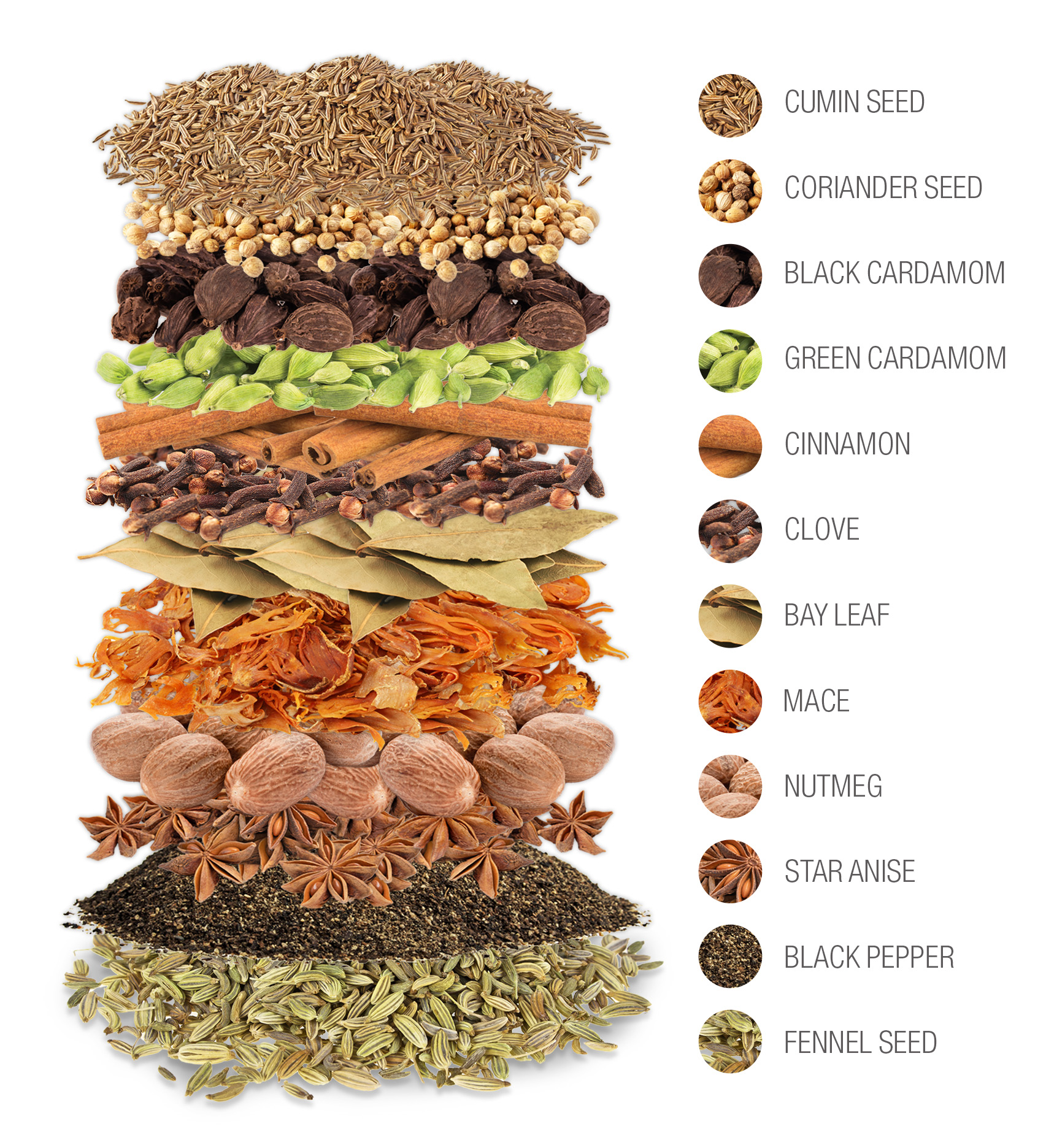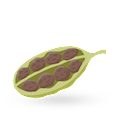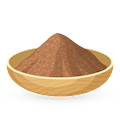TABLE OF CONTENTS
Best Indian Herb/Spice Types
MAIN INGREDIENTS
Garam masala is an intensely aromatic blend of ground spices such as cinnamon, cumin, cardamom, cloves, and peppercorns. Its name can be literally translated as hot ingredients, and is sometimes described as an aromatic blend that is meant to heat the body.
This spice blend has origins in Northern India, where winters are typically colder than in the rest of the country. The spices used in garam masala vary from region to region, but no combination of spices is believed to be more authentic than another.
THE BEST Garam masala Spice Blends and Seasonings
Curry leaves are leaves of the curry tree, which is native to India and Sri Lanka. The leaves are dark green in color, shiny, and aromatic, releasing a unique, nutty aroma when fried in oil. They are a staple of South Indian cuisine, used in the same way as bay leaves are used in Western cuisines.
The leaves soften significantly when cooked and are usually used as a flavoring to rice, chutneys, dals, soups, and stews. They are such a staple of Indian cuisine that the Tamil word for them is karibeppilai, which is literally translated to the leaf that is used to make curry.
Holy basil or tulsi is one of the varieties of basil originating from India. This plant has violet flowers and blossoms, while the stems are green with a purple tinge. It is much spicier than the other varieties of basil, so it's often called hot basil.
The leaves, seeds, and stems are often used for medicinal preparations, while the leaves are a staple of many Thai dishes due to their spicy flavor. Holy basil has numerous health benefits and it's used to treat stress, common cold, asthma, heart disease, fever, headache, and diabetes.
MAIN INGREDIENTS
Chaat masala is a spice mixture that's widely used in Indian, Pakistani, and Bangladeshi cuisine. It often consists of coriander, asafoetida, red chili powder, tamarind powder, cumin, amchoor (dry mango powder), and kala namak (black salt). The origins are somewhat murky, but it is believed that the spice blend was invented in the 17th century by Mogal emperor Shah Jahan's kitchen staff.
The flavors of chaat masala are best the day after it's been prepared, but it keeps for up to 3 months in airtight containers. Although it has an unusual aroma (mostly due to kala namak), people love it for its complexity and perfect flavors. It's recommended to use chaat masala on different Indian snacks called chaat, such as papri chaat, but it's also worth trying it over vegetables, salads, curries, dals, and fruit.
Amchur is a spice and condiment originating from India, but it's also often used in Pakistan. It's made from unripe mangoes that have been sliced, dried in the sun, then ground into a powder. The resulting powder has an intense aroma and tangy flavor.
It adds a nice level of acidity to a vast number of vegetarian dishes, especially in Northern India, where it's used in the same way as lemon juice or vinegar are used in other parts of the world. It's recommended to add amchur to curries, dals, pickles, and chutneys due to its fruity and tangy flavors.
Pav bhaji masala is a special spice blend used to make pav bhaji, a popular Indian street food. It is a mix of aromatic spices that provide the characteristic flavor and aroma of the dish. This masala typically includes coriander seeds, cumin seeds, red chili powder, turmeric, dry mango powder, black pepper, cloves, cinnamon, fennel seeds, cardamom, fenugreek leaves, and dry ginger powder.
The flavor profile of pav bhaji masala is a balanced blend of spicy, tangy, and earthy flavors, making it robust and savory without being overly hot. It is not only used in pav bhaji but also in dishes like tawa pulao, mixed vegetable curries, chaats, and spiced snacks.
MAIN INGREDIENTS
Bafat is a traditional Mangalorean blend of ground spices such as red chilis, cumin seeds, coriander seeds, peppercorns, mustard seeds, and turmeric. Each spice is dry-roasted separately until fragrant and slightly browned, then all of them are combined and ground to a powdery consistency.
The spices used for preparing this blend vary from one household to another, with each using their own unique selection of spices. This highly-aromatic and spicy blend is widely used in Mangalorean cuisine and is especially typical of the Mangalorean Catholic community.
Chettinad masala is a traditional spice blend originating from Tamil Nadu, India. The spice blend consists of 16 or more spices including cinnamon, green cardamom, mace, star anise, cloves, fenugreek seeds, black pepper, kapok buds, cumin seeds, coriander seeds, fennel seeds, mustard seeds, dry red chili peppers, curry leaves, poppy seeds, turmeric powder, grated coconut, and the key ingredient called stone flower.
Also known as kalpasi or dagad phool, stone flower is a unique spice that releases an intense aroma when tempered. The spices are dry-roasted in a particular order, then left to cool and pounded in a mortar with a pestle. Chettinad masala is usually used in various Chettinad curries, both non-vegetarian and vegetarian.
MAIN INGREDIENTS
Dabeli masala is a special spice mix used to flavor the potato filling in dabeli, a popular Gujarati street food. This masala is a blend of aromatic spices with a hint of sweetness and tanginess, giving dabeli its unique and rich taste. It typically includes ingredients such as coriander seeds, cumin seeds, dried red chilies, cinnamon, cloves, black peppercorns, fennel seeds, bay leaf, amchur powder or tamarind powder, and sugar or jaggery.
The flavor profile of dabeli masala is a balance of spicy, tangy, sweet, and aromatic notes, achieved through the combination of warm spices like cinnamon and cloves, the tanginess from amchur or tamarind powder, and the sweetness of sugar or jaggery.
TasteAtlas food rankings are based on the ratings of the TasteAtlas audience, with a series of mechanisms that recognize real users and that ignore bot, nationalist or local patriotic ratings, and give additional value to the ratings of users that the system recognizes as knowledgeable. TasteAtlas Rankings should not be seen as the final global conclusion about food. Their purpose is to promote excellent local foods, instill pride in traditional dishes, and arouse curiosity about dishes you haven’t tried.











